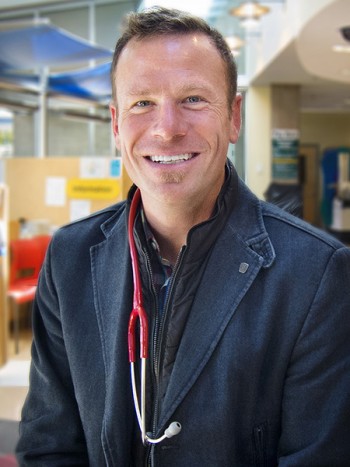 Age: 61
Age: 61
Position: Professor, Department of Urologic Sciences; Senior Research Scientist, Vancouver Prostate Centre.
Education: Bachelor of Science, University of Pittsburgh; Ph.D., Committee on Virology, University of Chicago; post-doctoral fellow, Roche Institute of Molecular Biology, New Jersey and Columbia University (Urology and Biochemistry).
Previous position: Professor, Pathology and Urology, Columbia University; Senior Scientist, Ordway Research Institute, Albany, N.Y. and Adjunct Professor, Division of Urology, Albany Medical College.
Distinctions: Member of editorial boards of Frontiers of Medicine, Journal of Urology, Prostate, Journal of Cellular Biochemistry and Urological Research; CapCure Foundation Award; Edwin R. Beer Award for Distinguished Research, New York Academy of Medicine; past President, Society of Basic Urological Research; member of Education Committee, American Urological Association.
Did you know? A sci-fi fanatic, I imagine myself as Riddick in a hostile future world.
Goal: Developing new, more robust treatments for advanced (metastatic) prostate cancer that far surpass the efficacies of contemporary hormonal therapies.
Quote: “Metastatic prostate cancer patients are typically treated with hormones that deplete testosterone or inactivate the cancer cell’s testosterone-response protein. While these approaches acutely reduce symptomatic complications and increase survival, they remain palliative as patients almost inevitably develop a more aggressive tumour that continues to advance. Moreover, hormone-treated prostate cancer patients suffer a considerable reduction in quality of life, since testosterone supports male physical vitality and a sense of well-being. More than 30 years of research has now led me to understand that hormone therapies can also change the developmental state of prostate cancer cells, allowing their regression to a more “stem-like” cancer cell. This reverse-developmental process confers a plasticity that allows them to re-differentiate, becoming less dependent on testosterone and thus more resistant to hormonal treatments. My intent is to target stemness-driven plasticity as a means of keeping the prostate cancer patient in a therapy-responsive state, and to even overcome the need for hormone therapies for this often lethal disease.
 Age: 43
Age: 43
Position: Associate Professor, Department of Pediatrics; Head, Division of Emergency Medicine, Department of Pediatrics, BC Children’s Hospital.
Education: Bachelor’s degree, Princeton University; M.D., Harvard Medical School; pediatrics residency, University of Washington, Seattle; pediatric emergency medicine fellowship, Children’s Hospital Los Angeles, University of Southern California; master’s in health services research, University of California Los Angeles, School of Public Health.
Previous position: Associate Professor, Fellowship Director and Assistant Section Chief, Pediatric Emergency Medicine, Oregon Health & Science University.
Distinctions: Developed and received accreditation for first and only pediatric emergency medicine fellowship in Oregon; Chair, Pre-Hospital Education Committee for Oregon Emergency Medical Services for Children; helped establish Pacific Northwest Pediatric Emergency Medicine Consortium; member, Scientific Review Committee, Pediatric Academic Societies; section editor, pediatric section, Tintinalli’s Emergency Medicine: A Comprehensive Study Guide; New England Pediatric Society Prize; Joseph B. Bilderback Teaching Award.
Did you know? My retirement plan is to return to school for a Master of Fine Arts to indulge my love of poetry and photography.
Goal: Help to create a happy, healthy, and fulfilled Division of Emergency Medicine that provides the best emergency care of children anywhere in Canada.
Quote: “I moved from the U.S. to Canada to practise within a more just and equitable health care system, and because of the amazing faculty members I had come to know through professional meetings. I am excited by the unique opportunity to provide outstanding local care to children, as well as help to elevate the care of children province-wide. I look forward to learning from those around me – colleagues, mentors, nurses, staff, and trainees – and helping to create an environment of camaraderie, enthusiasm, inquiry, and sharing of knowledge.”
 Age: 63
Age: 63
Position: Associate Professor, Division of Endocrinology, Department of Medicine and Director of Student Research, Southern Medical Program.
Education: Bachelor’s degree, master’s degree and Ph.D (Biochemistry and Experimental Surgery), McGill University; post-doctoral fellowship (oncology research), Mayo Clinic, Minnesota; MD and endocrinology and metabolism residency, University of Calgary.
Previous position: Associate Professor, Departments of Medicine and Community Health Sciences, University of Calgary; Medical Director, Vascular Risk Reduction Clinic and Hypertension Cholesterol Centre, Alberta Health Services.
Distinctions: Associate Dean’s Letter of Excellence for Small Group Teaching, University of Calgary; multiple Gold Star Letters for teaching from University of Calgary Medical School Students Association; Chair, Undergraduate Medical Education Electives Program; George Fodor Award for Prevention and Control of Hypertension in Canada; Stroke Services Distinction Award from Accreditation Canada; Co-Chair, Calgary Cardiovascular Network; Chair, Alberta Hypertension Initiative and Calgary Rotary Flames Centre of Excellence in Hypertension; implemented nationwide community-based participatory research project to reduce cardiovascular disease risk in Canadian South Asians.
Did you know? My health obsession has become a running joke among friends, colleagues and patients, because I end up attending most meetings in my biking or running clothes, and usually carry a bucket of veggies for sustenance.
Goal: To engage UBC’s Okanagan campus and the Kelowna community in efforts to decrease health disparities and improve the well-being of marginalized and diverse populations in B.C.’s Interior.
Quote: “I’ve seen the excitement and energy in the eyes of seniors who were trained to take blood pressure on other seniors. I’ve seen Australian Aboriginal communities devastated after researchers wrapped up their randomized controlled trials and went home, leaving inhabitants suddenly bereft of resources and support. I’ve seen students’ fear and aversion to the elderly dissipate through the experience of working and learning with them. These experiences that impassioned me to learn from, and work with, community members to improve their well-being. As Director of SMP student research, I can combine my passion for working alongside communities while engaging students and faculty in learning and research. We are mobilizing inter-professional Wellness Action Teams for Community Health (WATCH-BC teams), made up of students and faculty members, link curricular needs with community-identified public health needs.”